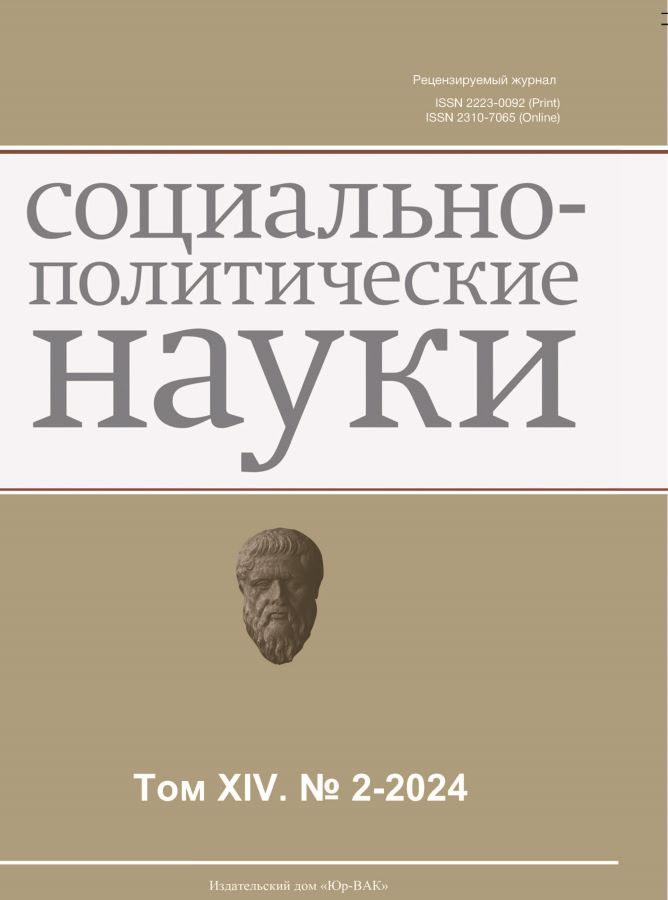The Rivalry of Regional and Non-Regional Actors in Central Asia in the Context of the Concept of Eurasianism
- 作者: Shangaraev R.N.1, Nogmova A.S.1, Ivochkina A.S.1
-
隶属关系:
- Diplomatic Academy of the Ministry of Foreign Affairs of the Russian Federation
- 期: 卷 14, 编号 2 (2024)
- 页面: 75-82
- 栏目: International Relations, Global and Regional Studies
- URL: https://journals.eco-vector.com/2223-0092/article/view/633835
- DOI: https://doi.org/10.33693/2223-0092-2024-14-2-75-82
- EDN: https://elibrary.ru/GVBGPB
- ID: 633835
如何引用文章
详细
The purpose of this research paper is to study Central Asia in the geopolitical space of Eurasia and the influence of extra-regional actors in the context of the “big game”. As a result of modern global political and socio-economic transformations in Russian science, forgotten ideas are being renewed, which marked the guidelines for the further development of the state, aimed at combating global challenges of our time, preventing interfaith and interethnic conflicts, uniting peoples, preserving national and territorial unity, and creating a vast and strong state. After the cold War, cultural geopolitical concepts were reinterpreted. Among them was the concept of Eurasianism, which has deep historical roots for the peoples of the region, including Central Asia in the context of the “Big Game” in Eurasia. The authors concluded that after the collapse of the USSR, the geopolitical situation in Central Asia underwent drastic changes. The importance of this region is reflected in the geopolitical theories of various world scientists, including the classics of geopolitics, including the concept of Eurasianism. The existing contradictions in the region and the struggle between the great powers for leadership are shaping global and regional instability in Central Asia.
全文:
作者简介
Ruslan Shangaraev
Diplomatic Academy of the Ministry of Foreign Affairs of the Russian Federation
编辑信件的主要联系方式.
Email: shang143@mail.ru
ORCID iD: 0000-0001-6557-4388
SPIN 代码: 2180-0229
Dr. Sci. (Polit.), Associate Professor, Department of Strategic Communications and Public Administration
俄罗斯联邦, MoscowAdelina Nogmova
Diplomatic Academy of the Ministry of Foreign Affairs of the Russian Federation
Email: adelinamid@mail.ru
Cand. Sci. (Polit.), Associate Professor, Department of Political Science and Political Philosophy
俄罗斯联邦, MoscowAnna Ivochkina
Diplomatic Academy of the Ministry of Foreign Affairs of the Russian Federation
Email: petukhova-anna@mail.ru
ORCID iD: 0009-0003-7551-3652
SPIN 代码: 6140-6987
Postgraduate Student
俄罗斯联邦, Moscow参考
- Ahrari E. The Strategic Future of Central Asia: A View from Washington. Journal of International Affairs. 2003. Vol. 56. No. 2. Pp. 157–66. EDN: JSTOR. URL: http://www.jstor.org/stable/24357724 (data of accesses: 08.02.2024).
- Blinken reaffirms U.S. support for Kazakhstan, endorses political reforms during first visit. The Astana Times. 01.03.2023. URL: https://astanatimes.com/2023/03/blinken-reaffirms-u-s-support-for-kazakhstan-endorses-political-reforms-during-first-visit/ (data of accesses: 27.02.2024).
- Avatkov V.A., Apanovich M.Yu., Borzova A.Yu. et al. Actual problems of international relations and foreign policy in the XXI century. 4th ed. Moscow: Dashkov and K, 2021. P. 226.
- Brzezinski Z. The great chessboard. Transl. from the English by O. Uralskaya. Moscow: AST, 2020. Pp. 218–219.
- Garbuzarova E.G. Central Asia in the context of the transformation of the world order: Dis. ... of Dr. Sci. (Polit.). 2022. Pp. 167–168.
- Spengler O. Sunset of Europe. Intr. art. by G.V. Dracha. Rostov-on-Don: Phoenix, 1998. 637 p.
- Zvyagelskaya I.D. In search of a fulcrum: Iran in Central Asia. INF. 12.11.2014. URL: https://russiancouncil.ru/analytics-and-comments/analytics/v-poiskakh-tochki-opory-iran-v-tsentralnoy-azii/ (data of accesses: 27.02.2024).
- Exodus to the East: The Statement of the Eurasians. Premonition and fulfillment. Article by P. Savitsky, P. Suvchinsky, N.S. Trubetskoy and G. Florovsky. Sofia: Russian-Bulgarian publishing House, 1921. Vol. VII. 125 p.
- Karpovich O.G., Shangaraev R.N. Central Asia in the context of modern geopolitics in the Eurasian space. Socio-political Sciences. 2021. Vol. 11. No. 6. Pp. 65–72. (In Rus.)
- Kozhokin E.M. The USA in Central Asia: The policy of “soft power”. International Life. 2023. No. 7. P. 19. (In Rus.)
- Mackinder H. The geographical axis of history. Transl. from English by V. Zhelninov. Moscow: AST, 2021. Pp. 43–67. (In Rus.)
- Sirochiddin S. The New Big Game in Central Asia: Conflicts and interests of Russia, China and the USA. Proceedings of the A. Bakhovaddinov Institute of Philosophy, Political Science and Law of the National Academy of Sciences Sciences of Tajikistan. 2020. No. 3. Pp. 150–156.
- Modern world politics. Textbook. Editorial board: S.S. Zhiltsov, T.N. Mosel, M.A. Neymark. E.P. Bazhanov (ed.); Diplomatic Academy of the Ministry of Foreign Affairs of Russia. Moscow: Dashkov and K, 2018. P. 313.
- Suju Ali Emre. Relations between the Russian Federation and the Turkish Republic in Central Asia: Identifying the balance of cooperation and rivalry. Dis. ... of Cand. Sci. (Polit.). P. 146.
- Meloyan T. Russia’s participation in the development of transport and energy corridors in Central Asia under sanctions. INF. URL: https://russiancouncil.ru/analytics-and-comments/columns/postsoviet/uchastie-rossii-v-razvitii-transportnykh-i-energeticheskikh-koridorov-v-tsentralnoy-azii-v-usloviyakh/ (data of accesses: 27.02.2024).
- Huntington S. The clash of civilizations. Transl. from the English by T. Velimeev. Moscow: AST, 2021. P. 497.
补充文件








